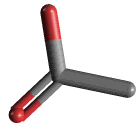|
STANNOUS ACETATE |
| Synonyms. Stannous acetate; Tin di(acetate); Tin(II) acetate; Tin acetate; Tin diacetate; Diacetoxytin; |
| PRODUCT IDENTIFICATION | |
|
CAS RN |
638-39-1 |
|
EINECS RN |
211-335-9 |
|
FORMULA |
Sn(CH3CO2)2 |
|
MOLE WEIGHT |
236.80 |
|
H.S CODE |
2915.29.5000 |
|
SMILES |
CC(=O)[O-].CC(=O)[O-].[Sn+2] |
|
CLASSIFICATION |
|
|
EXTRA NOTES |
Application: Reducing agent. |
|
|
| PHYSICAL AND CHEMICAL PROPERTIES | |
|
PHYSICAL STATE. |
white to off-white crystalline powder |
|
MELTING POINT |
180 ~ 183 C |
|
BOILING POINT |
|
|
DENSITY |
2.31 |
|
SOLUBILITY IN WATER |
Decomposes |
| SOLVENT SOLUBILITY |
Soluble in dilute HCl, acetone and ethyl acetate |
|
VAPOR DENSITY |
|
|
log P(octanol-water) |
|
|
VAPOR PRESSURE |
|
|
AUTOIGNITION TEMP |
|
| pK |
|
|
REFRACTIVE INDEX |
|
|
FLASH POINT |
|
|
|
| STABILITY AND REACTIVITY | |
| STABILITY | Stable under normal conditions. |
|
INCOMPATIBLE MATERIALS |
Oxidizing agents, Mineral acids. |
| POLYMERIZATION |
Has not been reported |
|
NFPA RATINGS |
Health: 2, Flammability: 0, Reactivity: 0 |
|
|
| EXTERNAL LINKS & GENERAL DESCRIPTION |
|
USA.gov - Stannous acetate Google Scholar Search - Stannous acetate U.S. National Library of Medicine - Stannous acetate PubChem Compound Summary - Stannous acetate NCBI (http://www.ncbi.nlm.nih.gov/) - Stannous acetate Material Safety Data Sheet - Stannous acetate sigmaaldrich.com |
|
|
| SALES SPECIFICATION | |
|
APPEARANCE |
white to off-white crystalline powder |
|
ASSAY |
99% min |
|
INSOLUBLES (IN DIL HCl) |
< 50 ppm |
|
TRACE ELEMENTS |
Al < 5 ppm |
|
|
| TRANSPORT & REGULATORY INFORMATION | |
|
UN NO. |
3146 |
| HAZARD CLASS |
6.1 |
| PACKING GROUP | III |
|
|
| SAFETY INFORMATION | |
|
HAZARD OVERVIEW |
GHS (Globally Harmonised System) Classification: Acute toxicity (Oral). Acute toxicity (Inhalation), Acute toxicity (Dermal). Hazard statements: Causes skin irritation. Causes serious eye irritation. May cause respiratory irritation. |
| SIGNAL WORD | Warning |
|
PICTOGRAMS |
|
|
HAZARD STATEMENTS |
H302 + H312 + H332 Harmful if swallowed, in contact with skin or if inhaled |
|
PRECAUTIONARY STATEMENTS |
P261 Avoid breathing dust/ fume/ gas/ mist/ vapours/ spray. |
| EC DIRECTIVES |
|
| HAZARD CODES |
|
|
RISK PHRASES |
20/21/22 Harmful by inhalation, in contact with skin and if swallowed. |
|
SAFETY PHRASES |
36 Wear suitable protective clothing. |
|
|
| PACKING |
|
Preserve in light-resistant and well-closed containers |
|
|
| PRICE INFORMATION |
|
|

